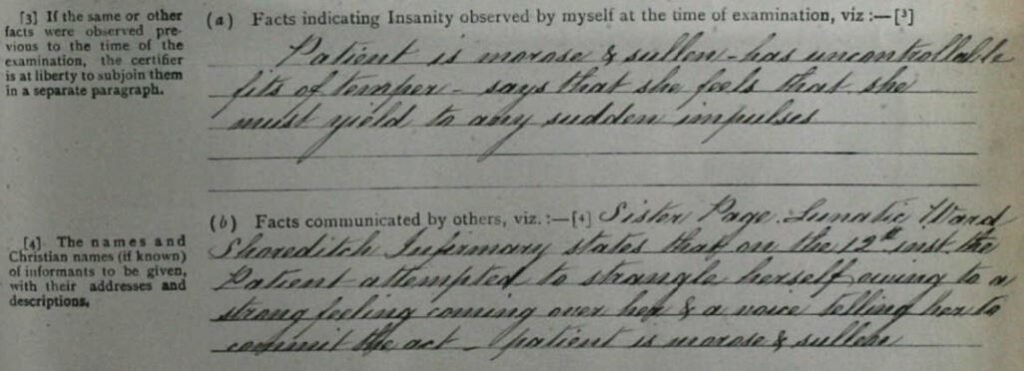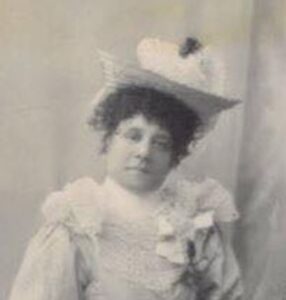b.1882? – d.1910
A tragic story of a young girl all alone, who lived in institutions from the age of three until her death at a young age.
Very little is known about where Gertrude was born. She herself did not seem to know much and whether she knew her parents is unknown. Perhaps no one bothered to ask. There is very little to go on and there is no definite trace of a Birth Certificate (Potentially Q2-1882, District Camberwell, County London Vol 1d Page 769).
What is known about her background is acknowledged within a lifetime of care.
Early institutional life
The first time anything can be found about Gertrude is in February 1885 when she is admitted to Hackney Union Workhouse aged 3 years old from the Infirmary on the 20th of that month. She is discharged alongside other children to Brentwood District Schools on 5th March 1885.

From the notes she has a Mother Mary R/A? at 1 Nisbet Street, Homerton, a very poor area. Described in Booth’s maps as being a “very poor area of chronic want”. It was 2 streets away from the Workhouse. The accompanying notebooks stated “prostitutes used to live here” and the area had the lowest semi criminal class.
No definite trace can be found of Mary at this time or indeed of any father, so from the little evidence we have we can only assume poor Gertrude came from a very poor background where her mother did not want her, or could not care for her, or maybe for some reason she was hidden from prying eyes.
Note: The Electoral Registers for Hackney, South Division, Homerton District (on which Nisbet Street is) shows no record of a ‘Sykes’ living in any of the Nisbet Street houses in 1885 or 1887 but there are gaps in the house numbers, and of course only the Males would be registered to vote. Number 1 is Mr George Couldridge but in a street a stones throw away Thomas Sykes is registered along with men matching several other surnames that appear with Gertrude on the workhouse records, could this be the father?
The Hackney Brentwood District Schools were poor law schools for orphaned or abandoned children and it appears Gertrude spent most of her younger years there. On 24 April 1887 she was admitted back to Hackney Workhouse along with other children, but only for one day and she returned back to the school with this same group. The purpose of this one day visit is not clear.
A short stay in a Convalescent Home – 1891
The next time we encounter Gertrude is another admission to the workhouse on 16th February 1891 where it states she was admitted from Rottingdean Convalescent Home. From this it can only be assumed that she was not a well child and after 3 days she was sent back to Brentwood School. On the register it again notes her Mother as “Mary 1 Elizth Homerton”. It is still not clear from this who her mother actually was.

At the time of the 1891 census she is shown as an inmate/scholar of the Brentwood School and noted place of birth as ‘Not known’ (Every child is listed with place of birth as Not Known).

Abuse and Torture
Gertrude is still at Brentwood Schools on 1894 when a scandalous case of abuse hits the headlines. A nurse from the school named Ella Gillespie went on trial accused of “systematic cruelty” over a number of years.
A witness stated that they saw Gertrude being beaten with nettles by Gillespie and undoubtably the poor child was on receiving end of some of Gillespie’s other awful punishments such as noted in the article;
- Knocking the children’s heads on the wall,
- Cutting their heads with a bunch of keys,
- Making the infants kneel with their bare knees on the wire guards over hot water pipes, and keeping them there,
- Forcibly immersing a child’s head in a bucket of water and keeping it there,
- Beating children on their hands and feet with a cane,
- The “ basket drill” which was alleged to have been practised,
- Keeping the children without water to drink when they were thirsty, in consequence of which they drank water from the pan of the water closet.
Gillespie was found guilty and sent to prison for 5 years. The Superintendent and the Matron were suspended. It is awful to think what terrible things these children endured.
Back in the Workhouse – 1900s
By 15 February 1899 when she is about 15 years old Gertrude is back at Hackney Union Workhouse sent from the Metropolitan Asylum in Margate. What she had been doing in the intervening years is unclear. The Asylum in Margate was opened in 1898 at East Cliff House and it specialised in treating Tuberculosis related illnesses, also rickets and ophthalmia, offering children seaside recuperation. Again, this is an indication that all is not well with Gertrude’s health, did she have TB? How long she was at the Workhouse this time round is not known as there are no discharge papers.
However, she was back again on 5 November 1900 admitted by the matron but now she is working as a servant aged 16. She is discharged at her own request on 22nd November 1900 but 4 days later she is back in the Workhouse.

By the time of the 1901 Census Gertrude can be found in another care environment, this time The Maternity Home of Rescue Society, Victoria House at 89 Central Hill, Upper Norwood, Surrey. Place of Birth ‘N.K’ {Not known}.

She is listed as an inmate involved in Laundry work. This establishment was a listed Children Home and listed as a home for fallen women or women who were likely to fall into trouble for the age group of 14 to 25-year olds. These establishments sometimes offered up to 12 months free support and moral reform. Laundry work was the most common work for these young women, it was considered symbolic cleansing. Whether Gertrude was pregnant or not or whether it was thought by the authorities she was at risk we will never know. I could find no record of a child being born.
Mental Health Decline
Gertrude is in real trouble and her mental health is at a very low ebb and it is the start of her journey into despair. From the Poor Law Removal and Settlement documents we can see that on 1st July 1902 she is admitted to Shoreditch Infirmary from 63 Clifton Street, Finsbury where she was working as a servant.
On 12th July it states that she “…attempted to strangle herself owing to a strong feeling coming over her and a voice telling her to commit the act, patient is morose and sullen”.

The medical examination of the 14th July shows this is the first attack, that she was not epileptic and not a danger to others. It went on to say she was “morose and sullen- has uncontrollable fits of temper – says she feels she must yield to any sudden impulse”. It also went on to say she had no known relatives so she was all alone in the world. As there were no vacancies in the London County Asylums on that date, it was decided she would be removed to Bethnal House and on 18th July she arrives there. It was noted she had no injuries but her hair was “nitty”.
Horton Asylum
By 9th September of that year there was finally space for her at the London County Asylums and Gertrude was removed to Horton where she remained until her death.

Her burial record gives an age of 26, but she is more likely to be 27 or 28. Gertrude died on 18th June 1910 and she is buried at Horton Cemetery on 23rd June 1910 in Grave 883B.
Author’s thoughts
Gertrude Sykes led a life of care, one of the forgotten lives from the most poor and deprived backgrounds of London. Unwanted and unloved by her family she may have been born with an illness or a disability as she did spend some time in Infirmaries and Convalescent Homes. Also, a period of time in a Maternity Home. Clearly her life was an unhappy one even whilst she was supposed to be in a safe environment of an educational setting, she was subject to systematic abuse from those who were meant to care for her.
All these things must have made their mark on her and after years of hardship and illness despite everything it all became too much for her and she tried to take her own life.
The later years of her life in a Mental Asylum would have not cured her and she must have remained in mental torment and possibly her death finally brought her the peace she deserved.





